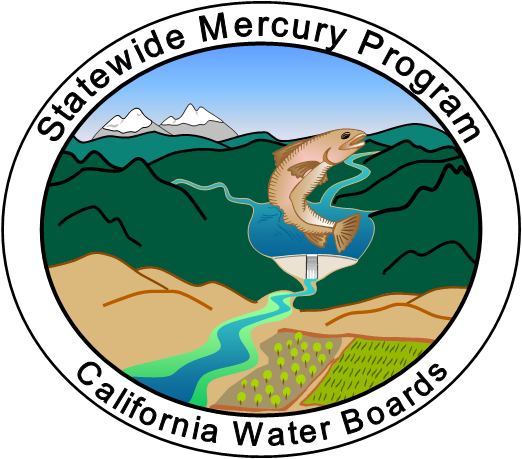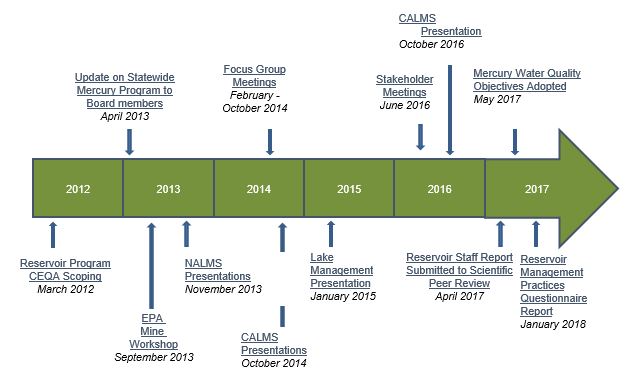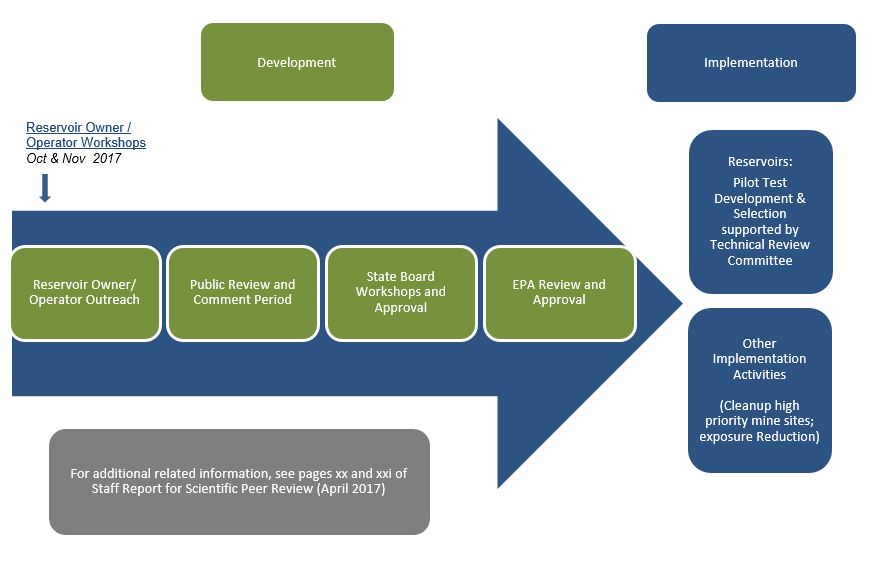Statewide Mercury Control Program for Reservoirs
Addressing Mercury in California's Waters
SUBSCRIBE TO UPDATES
Receive information by email about the Statewide Mercury Control Program for Reservoirs. Subscribe online to:
- Mercury - Statewide Control Program for Reservoirs

Mercury is negatively impacting the beneficial uses of many waters of the state by making fish unsafe for human and wildlife consumption. Although mercury occurs naturally in the environment, concentrations of mercury exceed background levels because of human activities. Gold and mercury mines and atmospheric deposition are the predominant sources of mercury, with minor contributions from industrial and municipal wastewater discharges and urban run-off.
State and Regional Water Board staff are developing a statewide water quality control program for mercury in reservoirs.
The Statewide Mercury Control Program for Reservoirs will address 131 reservoirs identified as mercury-impaired as of January 2018.
- NEW! Responses to the External Scientific Peer Review (September 2018); reviewers’ letters; and the documents submitted for peer review (April 2017) are available below
- Report Summarizing the Water Chemistry and Fisheries Management Questionnaire is available below
- Statewide Mercury Control Program for Reservoirs Introductory Fact Sheet (Updated June 2016).
- For more information on mercury sources in California, an explanation of how mercury accumulates in the food chain, and an analysis of factors affecting methylmercury accumulation in reservoir fish, refer to our Fact Sheet (2013 Fact Sheet).
For more information about the reservoir program, please email MercuryProject@waterboards.ca.gov,
Carrie Austin (510) 622-1015, or Lauren Smitherman (916) 464-4668.
Peer Review Documents
The external scientific peer review documents are provided here as a courtesy to stakeholders. The documents consist of: (a) Responses to the External Scientific Peer Review; (b) reviewer comment letters and instructions to reviewers; and (c) draft summary, staff report, and draft Mercury Reservoir Provisions (regulatory language) submitted to the reviewers. Please note that no written public comments will be accepted on these documents at this time. A formal notice will be provided to the public, likely in mid-2019 at the earliest, identifying the public review period along with release of documents for review and comments, including proposed Mercury Reservoir Provisions, Staff Report, and other relevant supporting documents.
- Responses to the External Scientific Peer Review (September 2018)
- External scientific peer reviewer comment letters and instructions to reviewers (August 2017)
- The following documents were submitted for external scientific peer review (April 2017):
- The revised draft summary of the Statewide Mercury Control Program for Reservoirs is available here (and is included in the draft staff report submitted for scientific peer review, which is posted below)
- Draft regulatory language, "Mercury Reservoir Provisions," full title:
Amendment to the Water Quality Control Plan for Inland Surface Waters, Enclosed Bays, and Estuaries of California-Mercury TMDL and Implementation Program for Reservoirs - Staff Report, full title:
Draft Staff Report for Scientific Peer Review for the Amendment to the Water Quality Control Plan for Inland Surface Waters, Enclosed Bays, and Estuaries of California, Mercury Reservoir Provisions - Mercury TMDL and Implementation Program for Reservoirs- Text, "Staff Report for Scientific Peer Review"
- Figures, "Staff Report Figures"
- Tables, folder of MS Excel tables, "Staff Report Tables"
- Appendices, folder of PDF files and MS Excel tables, "Staff Report Appendices"
- Draft regulatory language, "Mercury Reservoir Provisions," full title:
- The revised draft summary of the Statewide Mercury Control Program for Reservoirs is available here (and is included in the draft staff report submitted for scientific peer review, which is posted below)
Timeline
Two timelines are provided below. This first timeline shows past outreach through June 2017. The presentation materials from the listed events, including the CEQA scoping documents and comment letters, are available for your review.

Future Actions: This second timeline shows the next steps in the development of this program. The presentation materials from listed events are posted for your review.

Supporting Documentation
Reservoir Program CEQA Scoping (March 2012)
- CEQA Scoping Notice
- Public Scoping Presentation
- Project Summary
- Control Program for Mercury in California's Reservoirs Introductory fact sheet
- Public Comments Received
Update on Statewide Mercury Programs to Board Members (April 2013)
During the April 23, 2013 State Water Board Meeting, Water Board staff presented an update on recently adopted TMDLs and on the developing Statewide Mercury Program.
Environmental Protection Agency (EPA) Presentation (September 2013)
On September 26, 2013, Water Board staff gave a presentation at the EPA Region 9 State-of-the-Science Workshop on mercury remediation in aquatic environments as it relates to historic mines and other factors.
- Fish Mercury Impairment in California Reservoirs: Historic Mines and Other Factors
- A complete archive of the EPA workshop
Focus Group Meetings (February - October 2014)
Water Board staff held several small meetings with Tribes and stakeholder groups to inform them on the purpose and the initial scope of the proposed mercury amendment, and to gather feedback to aid in the development of the draft regulatory proposal.
- Focus group handout, provided a summary of program options under consideration and background
- Slides presented during the meetings
North American Lake Management Society (NALMS) Presentations (November 2013)
On November 1, 2013, Water Board staff presented at the 33rd International Symposium on important factors influencing predatory fish mercury concentrations in California reservoirs.
- Important Factors Influencing Predatory Fish Mercury Concentrations in California Reservoirs: A Statistical Approach
- Reservoir Management Strategies to Reduce Fish Mercury Levels: An Integral Part of the Statewide Reservoir Mercury TMDL
California Lake Management Society (CALMS) Presentation (October 2014)
On October 9, 2014, Water Board staff presented at the 29th annual CALMS meeting on the Statewide Mercury Control Program for Reservoirs and proposed in-reservoir mercury management options.
- Statewide Mercury Control Program for Reservoirs Overview
- Statewide Mercury Control Program for Reservoirs Study Options
Lake Management Presentation (January 2015)
On January 14, 2015, Professor Alex Horne at University of California, Berkeley presented information on in-reservoir mercury management options.
Stakeholder Meetings (June 2016)
On June 3, 2016 and June 9, 2016, Water Board staff held meetings in Riverside, CA and Sacramento, CA to discuss possible approaches to reduce fish methylmercury levels in reservoirs.
- Presentation: Statewide Mercury Control Program for Reservoirs Stakeholder Meetings June 3 and 9, 2016
- Handout: Draft Summary of Proposed Statewide Mercury Control Program for Reservoirs (May 2016)
California Lake Management Society (CALMS) Presentation (October 2016)
On October 13, 2016, Water Board staff presented at the 31st annual CALMS meeting on the Statewide Mercury Control Program for Reservoirs and proposed in-reservoir mercury management options.
Workshops for Reservoir Owners and Operators (October 11 and November 2, 2017)
On October 11 and November 2, 2017, Water Board staff held workshops with reservoir owner and operators in Big Bear and Sacramento. The intent of these workshops is to work towards engaging reservoir owner and operators in coordinated reservoir pilot tests.
- Technical staff report and handout
- Questionnaire on reservoir water chemistry and fisheries management
Reservoir Water Chemistry and Fisheries Management Questionnaire Report (January 2018)
Water Board staff prepared a report summarizing responses to a reservoir water chemistry and fisheries management questionnaire. The questionnaire was distributed to 131 mercury-impaired reservoirs throughout California in June 2017. The results were discussed at reservoir owner workshops during fall. Reservoir owner comments and ideas presented during the workshops are also summarized within the report.
Other Mercury Programs in California
Statewide Mercury Water Quality Objectives
The State Water Board is developing water quality objectives to protect humans and wildlife that consume locally caught fish. For more information, see Mercury Water Quality Objectives
Total Maximum Daily Loads for Mercury in California Waters
The Water Boards adopt and implement comprehensive pollution control plans, known as "total maximum daily loads," or TMDLs. A TMDL identifies the amount of a pollutant that a water body can hold and still be safe for uses by humans and wildlife.
Completed Mercury TMDLs (including date approved by U.S. EPA)
- Clear Lake Mercury TMDL (Central Valley Region, 2003)
- Guadalupe River Watershed Mercury TMDL (San Francisco Bay Region, 2010)
- Los Angeles Area Lakes TMDLs (Los Angeles Region, established by the U.S. Environmental Protection Agency)
- Walker Creek Watershed Mercury TMDL (San Francisco Bay Region, 2008)
- Cache Creek, Bear Creek, and Harley Gulch Mercury TMDL (Central Valley Region, 2007)
- Sacramento-San Joaquin River Delta Methylmercury TMDL (Central Valley Region, 2011)
- San Francisco Bay Mercury TMDL (San Francisco Bay Region, 2008)
- Sulphur Creek Mercury TMDL (Central Valley Region, 2009)
Mercury TMDLs in Development
- Big Bear Lake Mercury TMDL(Santa Ana Region)
Fish Consumption Advisories and Other State Efforts to Address Health Effects of Mercury
The California Department of Public Health and the Office of Environmental Health Hazard Assessment are educating people who eat local fish, about the types and amounts of fish that are safe and unsafe to eat.
Women of childbearing years and children are most at risk from mercury poisoning. For more information, see Safety Tips for Women and Children and General Health Advice for People Catching and Eating Sport Fish in California.Other Mercury Related Programs
An international team of scientists led by the U.S. Geological Survey recently documented widespread mercury contamination in air, soil, sediment, plants, fish, and wildlife at various levels across western North America. They evaluated potential risk from mercury to human, fish, and wildlife health, and examined resource management activities that influence this risk. Results of this synthesis are published in a special issue of Science of the Total Environment
- Comprehensive Study finds Widespread Mercury Contamination Across Western North America
- Synthesis of Mercury Distribution and Bioaccumulation Across Western North America



